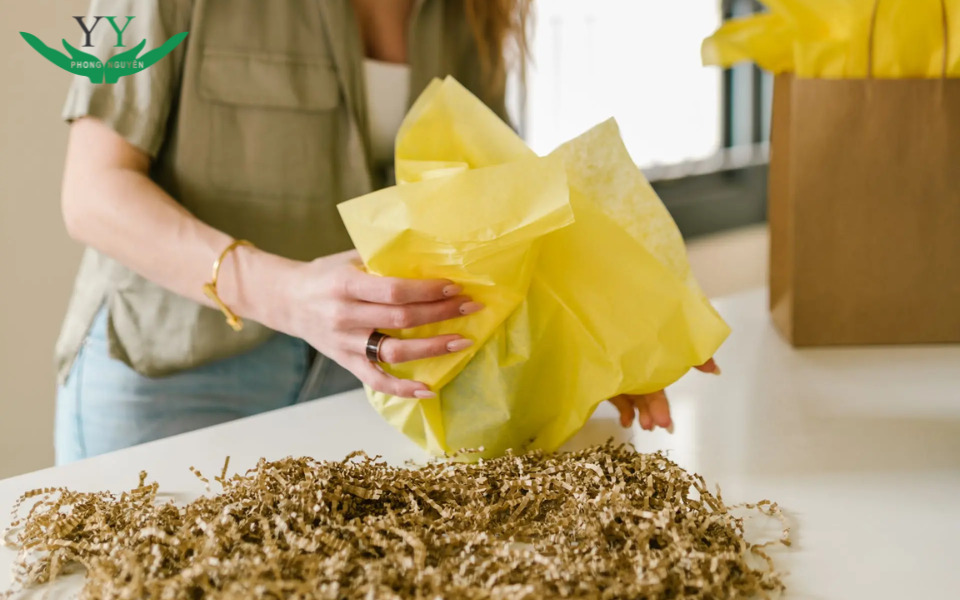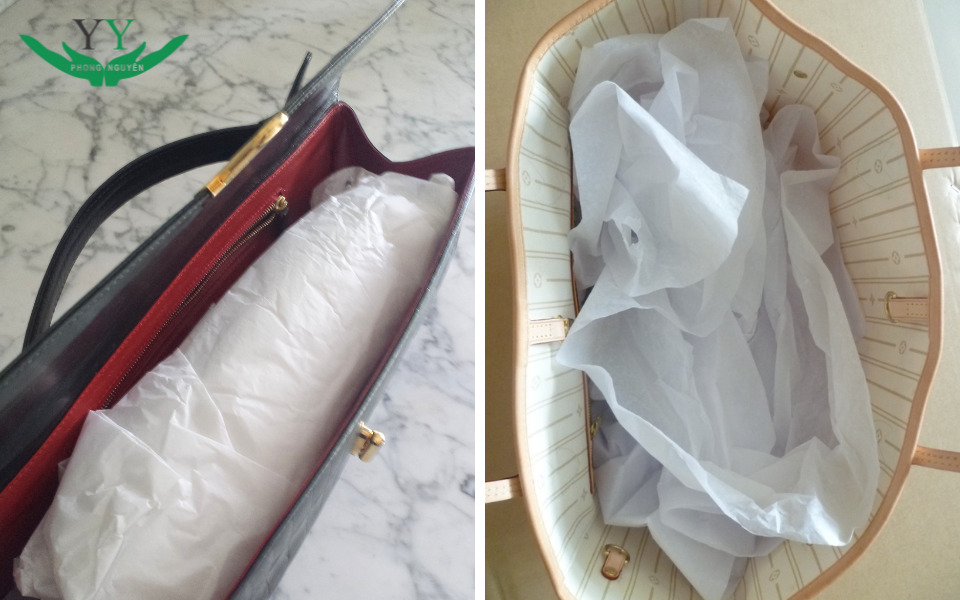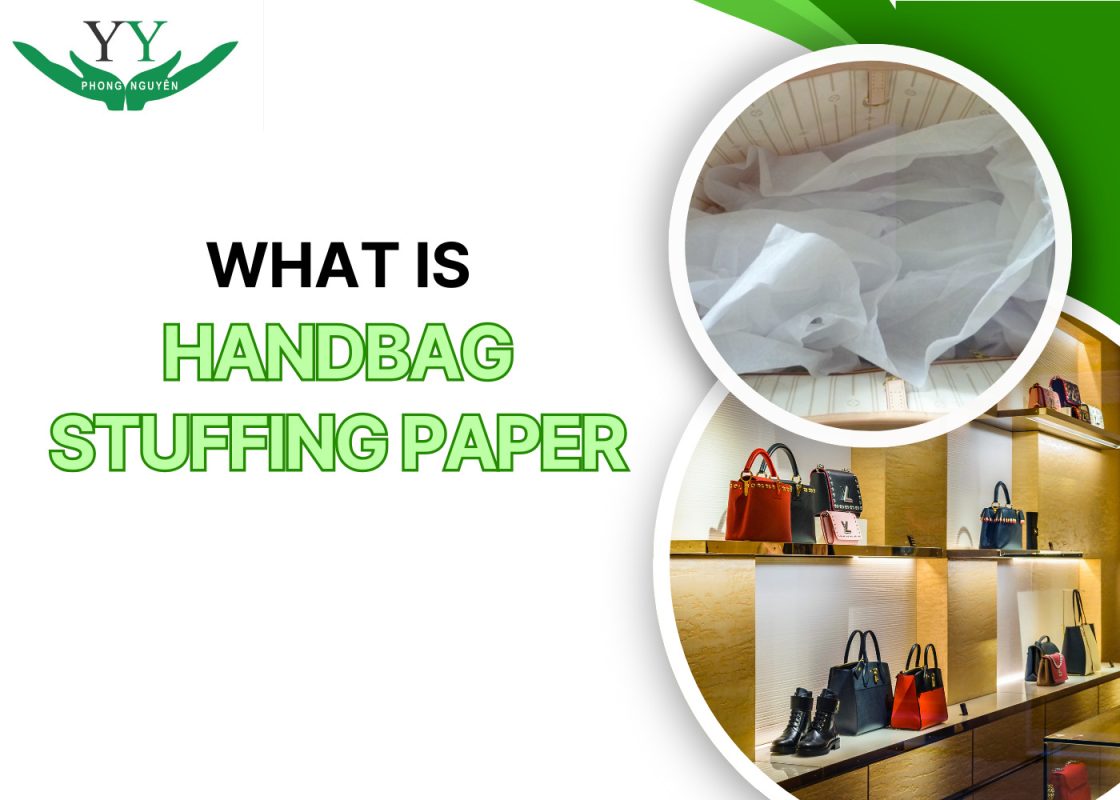Everyone wants their favorite handbag to stay beautiful and retain its original shape like when it was first purchased. However, not everyone knows how to properly care for their bag. One simple yet effective tip is to use stuffing paper. So, what exactly is handbag stuffing paper, and why has it become an essential item for handbag preservation?
What is Handbag Stuffing Paper?
Handbag stuffing paper (also known as form paper) is a type of insert paper used to fill or pad the inside of a handbag after it has been manufactured.

The primary purpose of using stuffing paper is to maintain the bag’s original shape and prevent it from sagging, deforming, or wrinkling during packaging, transportation, and display. Typically, handbag stuffing paper is made from soft types of paper such as kraft paper, tissue paper, crepe paper, or other eco-friendly recycled papers.
Functions of Handbag Stuffing Paper
In the handbag manufacturing industry, using stuffing paper is an important step in the product finishing process.
Maintains the Bag’s Shape
One of the main reasons for using stuffing paper is to help preserve the bag’s original form. When not in use, bags—especially those made of soft materials like genuine leather, suede, or fabric—are prone to deformation. Stuffing paper helps maintain the bag’s shape, preventing sagging, warping, or unwanted creases.
Protects the Bag from Moisture
In addition to shape retention, stuffing paper can absorb excess moisture inside the bag, which is especially helpful in the humid climate of Vietnam. This is particularly important for bags made from natural materials like genuine leather, as excessive humidity can lead to mold, odors, and reduced product lifespan.

Protects Bag Details and Accessories
Stuffing paper not only protects the main body of the bag but also helps secure and safeguard smaller components such as zippers, buttons, straps, and other accessories. Keeping the bag in a stable form prevents direct pressure on these parts, reducing the risk of bending, breakage, or scratching, thus preserving both aesthetics and function.
Enhances Product Display
When displayed on shelves or in glass cases, bags that are properly stuffed retain a plump, visually appealing shape. This gives the product a more professional appearance, showcasing its design and intricate details. A well-shaped bag is far more likely to catch a customer’s eye than one that looks slumped or deformed.
Maintains Aesthetic and Product Longevity
Without proper shape maintenance, undesirable creases can form, especially at stress points or seams. Over time, these creases can become permanent, diminishing the bag’s original beauty. Stuffing paper fills the interior space, preventing sagging or distortion, thereby extending the aesthetic lifespan of the bag.
Types of Paper Used for Stuffing Handbags
There is a wide range of paper types used for handbag stuffing, depending on softness, moisture absorption, cost, and aesthetic requirements. Below are some common options:
- Kraft Paper: The most widely used due to its durability, strength, and affordability. Available in natural brown or white, kraft paper is often used for everyday handbags, especially those with a rustic, natural style.
- Pelure Paper (Tissue Paper): Thin, soft, and silky-smooth, pelure paper is often used for luxury bags, leather goods, or delicate products prone to scratching. Besides maintaining form, it adds a touch of elegance and protects the product’s surface.
- MG (Machine Glazed) Paper: This paper has one glossy and one rough side, offering good moisture absorption. MG paper is commonly used for stuffing shoes and bags to retain shape and prevent mold.
- Industrial Tissue Paper: Soft, lightweight, and highly absorbent, tissue paper is used to stuff soft handbags or products that need gentle protection.
- Recycled Paper: An environmentally friendly choice made from recycled scraps. Recycled paper comes in various weights and colors, suitable for stuffing different types of handbags depending on specific needs.
- Duplex, Ivory, and Couche Scrap Paper: In paper bag manufacturing, leftover or substandard pieces from these types can also be repurposed as stuffing paper, helping to cut costs and reduce waste.
Guide to Properly Stuffing Your Handbag
Stuffing your handbag correctly is crucial to preserving its original shape, preventing damage, and extending both its lifespan and appearance. Follow this detailed guide to ensure your beloved bags stay in pristine condition:
Step 1: Clean the Interior
Before stuffing the bag, inspect and thoroughly clean the inside. Over time, dirt or residues such as ink stains, crumbs, coins, or other debris can accumulate. Use a soft cloth to wipe down the inner lining, including small pockets and corners. For fine dust or hard-to-reach particles, a handheld vacuum with a soft brush attachment works well.

Step 2: Choose the Right Stuffing Paper
Choosing the appropriate stuffing paper will help maintain your bag’s shape effectively. Consider the bag’s size, shape, and material. For genuine leather bags, opt for acid-free tissue paper or clean soft fabric to avoid scratching the lining or color fading. For more casual fashion bags, crumpled kraft paper or newspaper may suffice.
Step 3: Stuff the Bag
How you distribute the stuffing inside affects the shape retention. Begin by placing paper in the corners—the most vulnerable areas to bending or wrinkling. Then continue filling the center, ensuring the paper is evenly distributed for a balanced shape.

Step 4: Secure the Handles and Use a Protective Cover
Once stuffed, pay special attention to the handles. Letting them hang freely during long-term storage can cause stretching, creases, or damage. Fold the handles neatly and place them inside the bag with the stuffing paper, or roll them and place them in a separate cloth pouch. For metal chains, wrap them in acid-free tissue paper to avoid scratching the bag’s surface.
Step 5: Store the Bag Properly
Store the bag upright on a shelf or in a designated storage area—ideally in a cool, dry place away from direct sunlight. Avoid stacking multiple bags on top of one another, as the weight can deform the ones underneath, even if they’re already stuffed. If bags need to be stored close together, ensure there is space between them to prevent pressure or friction.
Conclusion
Using handbag stuffing paper may seem simple, but it plays a crucial role in preserving the bag’s shape and extending its life. If you’re looking for high-quality, safe stuffing paper suitable for a variety of handbags and footwear, Phong Nguyen is the ideal choice for you.

